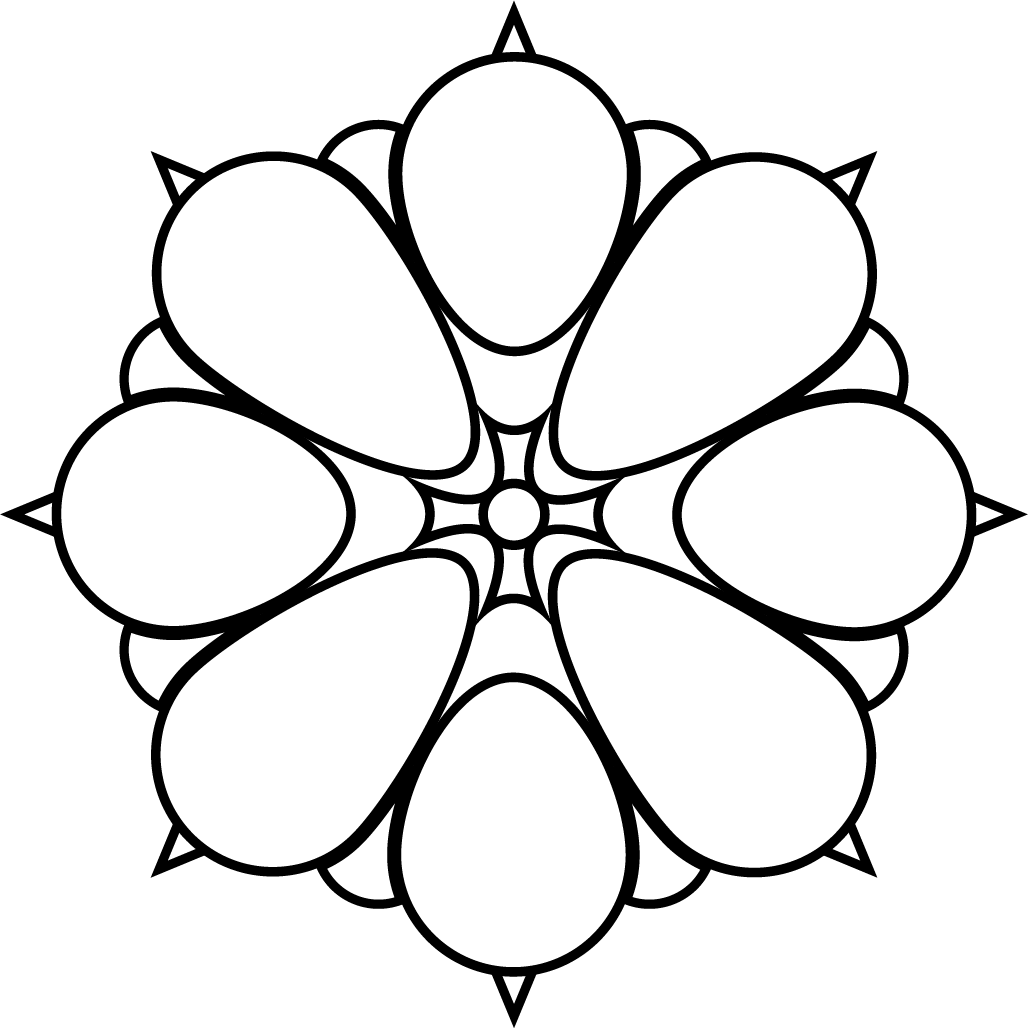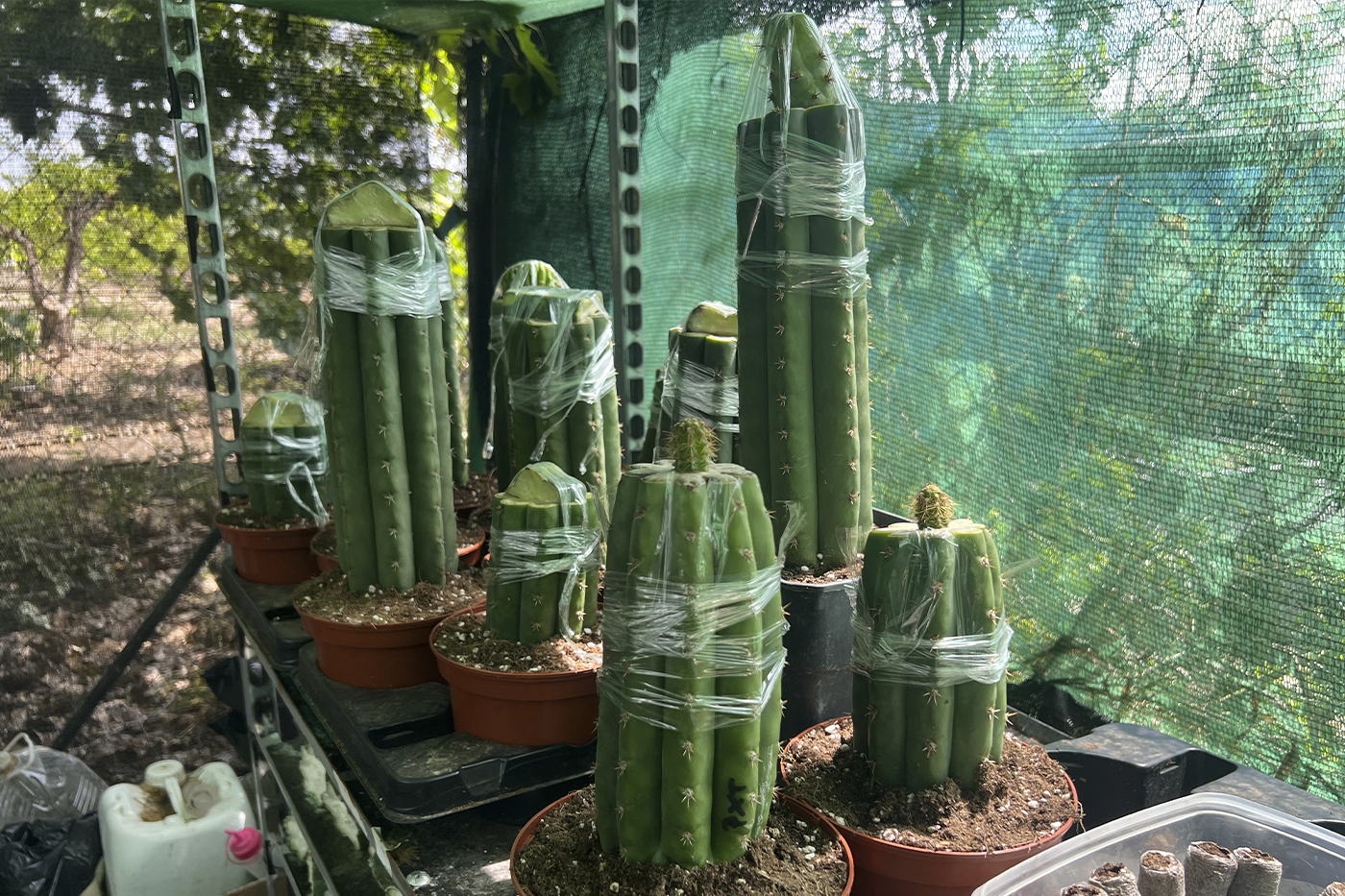The use of Trichocereus (syn. Echinopsis in the broad sense) as rootstock in cacti is a well-established strategy in advanced collecting and nursery production. Its vigor, relative cold tolerance, robust root system, good diameter stems, and ease of handling make it a solid foundation for accelerating growth, rescuing valuable material, or multiplying crested and variegated forms.
At TRICHOLAND, we work with species such as T. spachianus, T. pachanoi, T. peruvianus/macrogonus, T. bridgesii (syn. Echinopsis lageniformis) and, for large-gauge grafts, T. terscheckii as field bases. This guide summarizes compatibility criteria by genera, comparisons with other rootstocks, grafting protocols, and long-term management practices to minimize incompatibilities and maximize the lifespan of the grafted pair.
Why Use Trichocereus as Rootstock?
- Vigor and Diameter: Fast growth with stems measuring 6–15 cm in diameter that facilitate cambial alignment with small to medium grafts.
- Robust Roots: Good anchorage and absorption, tolerating mineral substrates and deep, spaced watering.
- Climatic Tolerance: Greater endurance to short, dry cold than tropical rootstocks (useful in USDA Zones 9a–10b).
- Longevity: Longer lifespan than Hylocereus in temperate climates; renewable through cutting and regrowth.
- Broad Compatibility: High success rate with numerous genera of Cactoideae.
Compatibility by Genera (Practical Nursery Perspective)
Cactus compatibility is broad but not absolute. Greater taxonomic and physiological closeness generally leads to better mid- to long-term performance. We classify practical experience into four levels:
High Compatibility (Generally Stable and Vigorous Grafts)
- Trichocereus/Echinopsis (intrageneric): cultivars, crested/monstrous forms.
- Gymnocalycium (except high-consumption non-chlorophyll cultivars, see notes): excellent for seed production and variegated forms.
- Astrophytum (incl. myriostigma, capricorne, asterias): rapid growth and early flowering.
- Lophophora (all species): very stable long-term for multiplication and fruiting.
- Turbinicarpus, Rebutia/Sulcorebutia, Frailea, Mammillaria (many species): good overall affinity.
- Ferocactus and Echinocactus (juveniles/medium-sized): acceptable, useful for accelerating juvenility.
Medium Compatibility (Good Success, Review Mid-Term)
- Ariocarpus: takes and grows well; after 5–10 years, necks or imbalances may emerge; preferable to renew on time or switch to Harrisia jusbertii (see intergrafts).
- Copiapoa: variable depending on species/clone; manage conservative watering to avoid excessively watery tissues.
- Obregonia, Pelecyphora: generally positive, watch for “bottle-necking.”
- Echinocereus: heterogeneous; many respond well, while others show uneven growth over time.
Delicate Compatibility (Graft for Temporary Purposes or with Intergraft)
- Aztekium and Geohintonia: possible to graft, but frequent late incompatibilities and tense tissues. Often performs better on Harrisia (Eriocereus) jusbertii or intergrafted between Trichocereus and the scion.
- Uebelmannia: sensitive; better on warm-tropical stocks or Harrisia in controlled conditions.
- Discocactus and Melocactus: require stable heat year-round; on Trichocereus in cooler climates, they conflict due to the winter dormancy of the stock.
- Blossfeldia: viable after a phase on Pereskiopsis, but long-term, better to consider specific alternatives.
Low/Not Recommended
- Epiphytic Cacti (Schlumbergera, Rhipsalis, Epiphyllum): distinct physiology; prefer Hylocereus or Selenicereus.
- Opuntioideae (Opuntia/Consolea, etc.): very limited compatibility with columnar Cactoideae.
Note on “moon cactus” (Gymnocalycium without chlorophyll): Trichocereus can support them, but totally achromatic clones usually require very high flow and thrive better on ultra-vigorous stocks like Hylocereus/Selenicereus in warm environments. In colder climates, maintaining in a warm indoor setting with Trichocereus is possible.
Choosing a Trichocereus Species as Rootstock
- T. spachianus: standard in nurseries. Fast, straight, easy to obtain, good performance in pots and soil. Excellent balance of vigor/robustness.
- T. pachanoi (syn. Echinopsis pachanoi): very vigorous and versatile; ideal for medium and large grafts; roots easily and regrows after cuts.
- T. peruvianus / macrogonus: similar to pachanoi; vigorous clones perform very well.
- T. bridgesii: slightly thinner; excellent in pots, good cold-dry tolerance.
- T. terscheckii: slow but extremely robust; ideal as a long base for展示 grafts or in gardens.
Quick Comparison with Other Rootstocks:
- Pereskiopsis: unbeatable for seedlings (micrografting); temporary, then transfer to Trichocereus/Myrtillocactus/Harrisia.
- Myrtillocactus geometrizans: very fast and easy; less cold-tolerant than Trichocereus; good lifespan in mild temperate conditions.
- Harrisia (Eriocereus) jusbertii: high long-term compatibility with “difficult” Mexican species (Ariocarpus, Aztekium, Geohintonia); excellent as intergraft.
- Hylocereus/Selenicereus: maximum vigor in heat; very sensitive to cold; short lifespan in temperate climates.
Intergrafts: When and How
If the scion is “delicate” with Trichocereus, use an intergraft (bridge) to improve compatibility and physiology:
- Trichocereus → Harrisia jusbertii → Aztekium/Geohintonia/Ariocarpus: very stable combination in the long term.
- Trichocereus → Myrtillocactus → ultra-slow-growing scions: accelerates but advisable to renew every few years.
The intergraft should have a matching section and be well-rooted; perform a flat graft from stock to intergraft, let consolidate for 2–3 weeks, and then graft intergraft to scion.
Grafting Protocol on Trichocereus (Professional Level)
Optimal Timing
- Late Spring to Summer with stable temperatures (22–30 °C) and actively growing stock.
- Avoid cold spells or extreme heat; in a greenhouse, provide bright light with light shade (30–40% mesh).
Preparation of the Rootstock
- Water the Trichocereus 2–4 days beforehand (turgid tissues but dry surface on the grafting day).
- Sterilize tools (flame/70% IPA). Make a clean, flat cut perpendicular to the axis, removing 2–3 mm of outer bark if corky.
- If the cut shows “buds” or soft tissue, trim until reaching firm and homogenous tissue.
Preparation of the Scion
- Fresh scions with a clean cut. If from cuttings, allow to dry for 1–3 days until the surface tightens without forming excessive callus.
- In seedlings, ParaFilm can be used for handling and anchoring.
Union and Fixation
- Cambial Alignment: center the scion over the cut, ensuring at least 1-2 points of the vascular ring coincide (a slight offset often enhances the overlap of rings).
- Firm, Even Pressure: use rubber bands, elastic tape, or strips of a tire. Avoid movement for 5–10 days.
- Conditions: 24–28 °C, RH 50–70%, bright light without direct sunlight. No humidity dome on medium/large scions.
- Check after 7–10 days: if there’s a good attachment, gradually remove tension; first light watering 3–5 days later in mild substrate.
Specific Techniques
- Flat Grafting: the most commonly used method for globular cacti.
- Side/Splice Grafting: useful when the scion diameter is smaller; promotes matching of rings.
- Wedge Grafting: for columnar scions; make a vertical slit in the stock and embed the wedge.
Management of the Grafted Pair
- Light: gradually increase until full sun depending on the species of the scion; avoid initial sunburns.
- Watering: deep and spaced, allowing to dry thoroughly. Avoid “peaks” that can cause tissue expansion in the scion.
- Nutrition: 50–80 ppm N per application during growth, low-N high-K formula with micros. Avoid excess salts (periodic washout).
- Pruning the Stock: remove lateral shoots from the Trichocereus to concentrate sap on the scion.
- Renewal: if ascending corking or severe narrowing appears, regenerate with re-grafting to a new Trichocereus apex or switch to a compatible intergraft.
Common Issues and Solutions
- Scion Displacement: use greater pressure and stable base; retry grafting with a fresh cut.
- Late Incompatibility (neck, hardened tissue, growth halt): transfer to Harrisia jusbertii as intergraft or switch to their own roots if the material allows.
- Excess Vigor from Stock (scion “hydroponic,” thin skin): reduce watering and N, increase K/Si and more light.
- Rot Issues: nearly always due to humidity/cold. Sanitize down to healthy tissue, use sulfur on cuts, and retry in a warmer and drier season.
- Bottle-neck and fracture risk: re-graft higher on a larger stock or practice bridging with an intergraft.
Recommended Calendar (Northern Hemisphere; invert for Southern Hemisphere)
- Apr–Jun: optimal grafting window; maximum success rate.
- Jul–Aug: grafts possible, avoid heat spikes; provide light shading.
- Sep: last grafts in temperate regions; prepare for dry wintering of stock.
- Oct–Mar: avoid grafts unless in a climate-controlled greenhouse; keep stocks dry and dormant.
Use Cases and Recommendations by Objective
- Rapid Seed Production: graft Ariocarpus, Astrophytum, Lophophora, Gymnocalycium onto T. spachianus/pachanoi. They flower earlier and more prolifically.
- Rescuing Damaged Specimens: healthy discs on fresh Trichocereus stock; high recovery rate.
- Exhibition of Crested/Monstrous Forms: Trichocereus provides mechanical support and a continuous supply with good outdoor tolerance.
- “Difficult” Long-Term Species: use Harrisia jusbertii intergraft for Aztekium/Geohintonia and some Ariocarpus.
Frequently Asked Questions
- Which Trichocereus is “better” as rootstock? For general use: T. spachianus and T. pachanoi due to availability, vigor, and stability. For monumental bases: T. terscheckii.
- How long do grafts last on Trichocereus? With good management, several years to over a decade. Renew when the stock excessively corks or the scion shows neck.
- Can I graft in winter? Only in controlled environments (24–26 °C, light and ventilation). Outside/temperate, it's better to wait until spring.
- Do I need hormones or sealants? They are not essential; the key is clean cuts, alignment, and pressure. Sulfur powder helps dry surfaces if exudates are present.
Good Practices for Plant Health
- Strict Hygiene: use sterile blades, clean surfaces, disinfected hands/gloves.
- Quarantine incoming material for 3–4 weeks to avoid mealybug (airborne and root), mites, and fungi.
- Very Draining Substrate (50–70% mineral) and watering with low-salinity water. A pH of 5.8–6.2 in watering promotes absorption and prevents chlorosis.
- Control of Stock Sprouts: periodically trim shoots.
Summary Practical Sheet
- Recommended Stocks: T. spachianus, T. pachanoi, T. peruvianus/macrogonus, T. bridgesii; for XXL bases: T. terscheckii.
- High Compatibility: Echinopsis/Trichocereus, Gymnocalycium, Astrophytum, Lophophora, Turbinicarpus, Rebutia/Sulcorebutia, Frailea, many Mammillaria.
- Useful Intergrafts: Harrisia (Eriocereus) jusbertii, Myrtillocactus.
- Time Frame: late spring–summer; 24–28 °C.
- Key to Success: clean cuts, alignment of rings, constant pressure, tempered and dry environment.
TRICHOLAND: Professional Rootstocks and Consulting
At TRICHOLAND, we produce Trichocereus rootstocks selected for vigor, straightness, rapid rooting, and climatic tolerance. We provide specific calibers for each type of graft, as well as mother plants and ready-to-use columns for “top-grafting.” Our technical team can design your grafting protocol by genus/objective (seed production, rescue, exhibition), select intergrafts when appropriate, and define the subsequent cultivation plan (substrate, fertigation, light management, and health).
If you need a homogeneous lot of T. spachianus for your grafting bank, bases of T. pachanoi, or columns of T. terscheckii for collection pieces, contact us: we tailor the material to your climate and production program.




